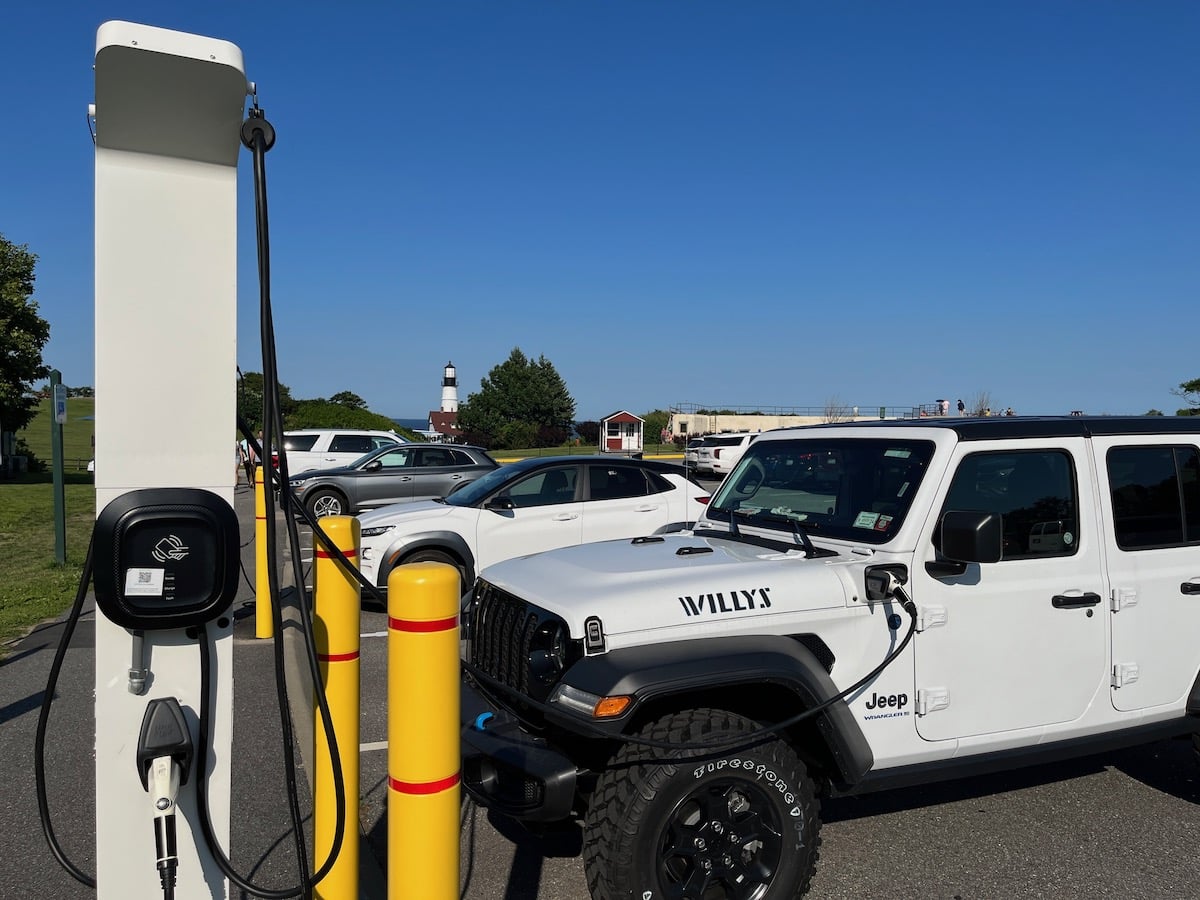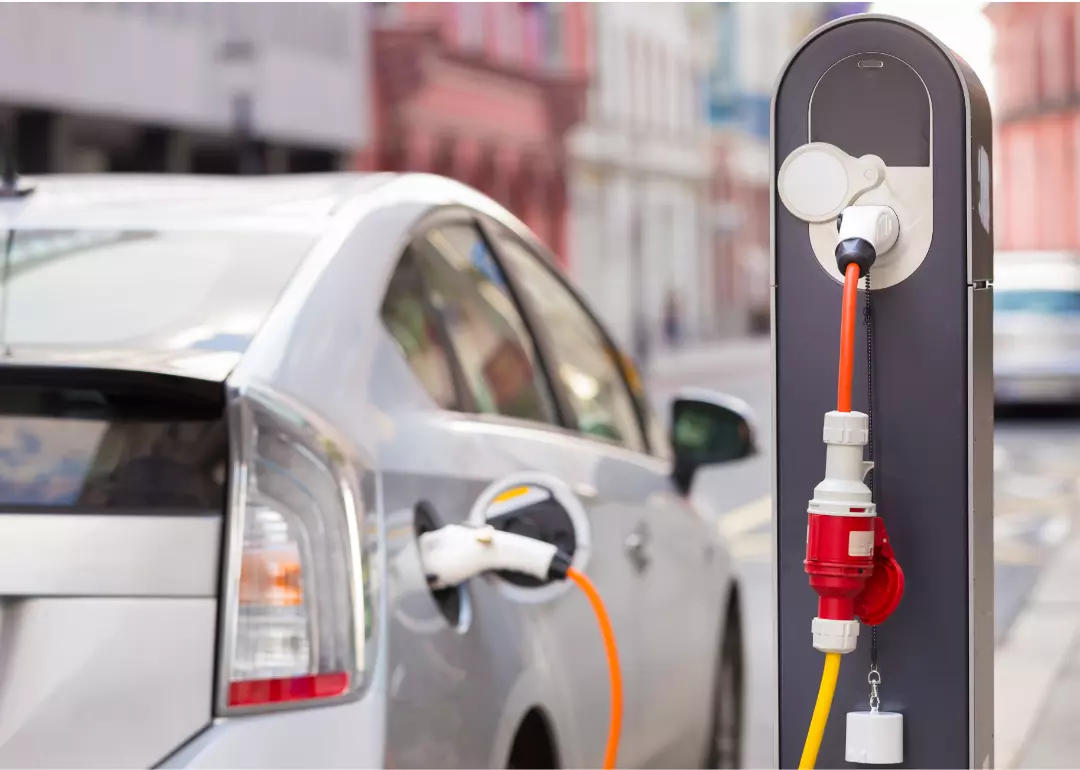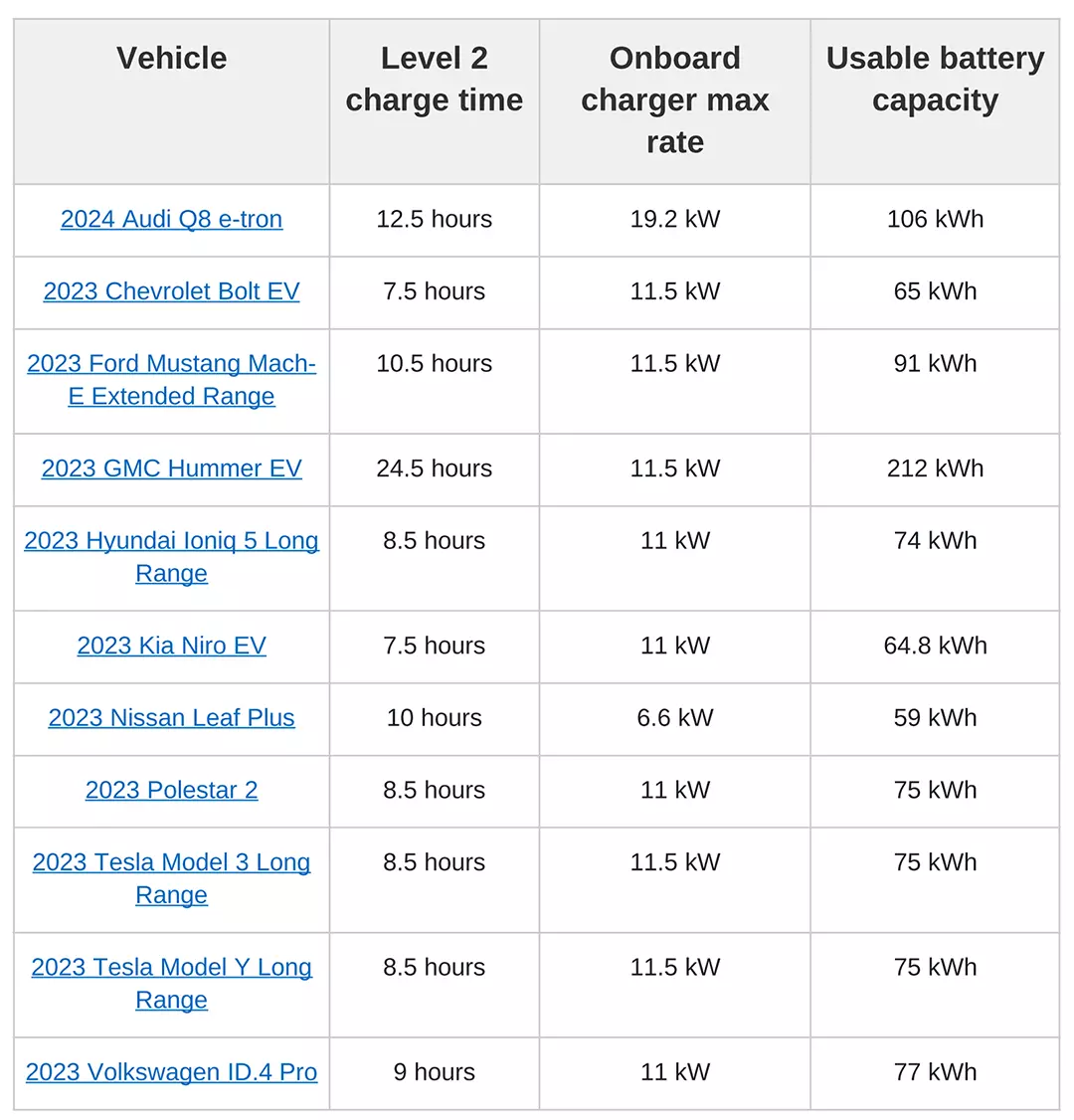
[ad_1]
One in every of many questions people have sooner than purchasing for an EV is how prolonged does it take to price {an electrical} vehicle. They worry that it will take too prolonged to take the automotive on a go to.
One different problem that will preserve any individual once more from getting {an electrical} automotive: will they run out of battery vitality sooner than attending to their trip spot. That’s known as range nervousness, says Automotive World.
One in every of many causes I wrote my article on Marriott lodges with EV chargers was to help readers know the place they could price up. Now, I’m using this knowledge from Stacker.com to share detailed knowledge on how prolonged to price {an electrical} vehicle. Hopefully, this may make it simpler to understand the logistics of EV vehicle charging.

How prolonged does it take to price {an electrical} vehicle?
This internet web page would possibly comprise affiliate hyperlinks, which suggests I is also compensated for individuals who click on on a hyperlink. Nonetheless, there’s no worth to you. Moreover, as an Amazon Affiliate, I earn from qualifying purchases. For extra data, please see my Privateness and Disclosure internet web page.
How prolonged does it take to price {an electrical} vehicle? Properly, it depends on the type of vehicle and the type of charger you make the most of.
As an illustration, it will possibly take eight hours to price a typical electrical automotive from empty to full using a Diploma 2 home charger. This assumes a usable battery functionality of 70 kWh and a value price of 9.6 kW.
Nonetheless, for individuals who use Diploma 1 charging — as in an on a regular basis household outlet — you’ll need 65 hours to price the an identical EV. Then once more, a DC fast charger might theoretically do the job in about an hour.
To calculate how prolonged it often takes to attain full functionality for numerous price costs, Edmunds took a greater check out variables that resolve how prolonged {an electrical} vehicle will take to price.
What are the weather that affect electrical vehicle price situations?
Listed below are 5 key components that resolve the charging time of {an electrical} vehicle:
- Car battery dimension
- Charging station tempo
- The auto’s inside charge-rate limits
- Temperature and local weather conditions
- Battery price proportion
How does battery dimension affect charging?
A much bigger battery will take longer to price than a smaller battery, all else being equal. EV battery sizes right now range from spherical 30 kWh to larger than 200 kWh.
Want to Save This Article?
Save this textual content and we’ll ship it to your inbox. Plus, we’ll ship you further good hyperlinks each week.
By submitting this sort, you consent to acquire emails from Leah Ingram
For example the have an effect on of battery dimension on charging time, have in mind two EVs, every using Diploma 2 charging (further on that inside the subsequent half) at a price of 9.6 kW. That is the best-case scenario for home chargers utilizing the frequent NEMA 14-50 wall outlet.
Thought of one among our EVs has a usable battery functionality of 40 kWh, the other 80 kWh. Not surprisingly, double the battery dimension means double the charging time:
Usable battery functionality: 40 kWh
Diploma 2 charging time (9.6 kW): 4.5 hours from empty to full
Usable battery functionality: 80 kWh
Diploma 2 charging time (9.6 kW): 9 hours from empty to full
What are the completely totally different charging station speeds?

That’s the EV equal of gas-pump tempo, and there are efficiently three speeds to focus on, in order from gradual to fast:
- Diploma 1
- Diploma 2
- DC fast charging or Diploma 3.
Diploma 1 charging
The Diploma 1 charging means using an odd outlet in your home. Diploma 1 might be essentially the most useful method however as well as the slowest, charging at roughly 1.2 kW.
As an illustration, a 2023 Chevrolet Bolt EV, using an odd 120-volt outlet, will take roughly 60 hours to get to a full price from empty. On the acute end, a 2023 GMC Hummer EV, which has an unlimited battery, might take 200 hours — eight days! — to price completely using the an identical outlet.
Then once more, Diploma 1 charging is best for plug-in hybrids, such as a result of the Toyota Prius Prime. This vehicle has a modest 13.3-kWh battery that is likely to be completely charged in about 12 hours.
Diploma 2 charging
With Diploma 2, this charging makes use of a 240-volt outlet and represents the quickest method to price at home. That’s because of one thing increased can solely be current in industrial or industrial settings.
Diploma 2 chargers may very well be found at your workplace, out in public and at home. You’ll in all probability need an electrician to place in a 240-volt outlet or affirm while you’ve bought the proper outlet and if your home can accommodate the extra entice vitality.
The an identical Chevy Bolt we referenced earlier would take 7.5 hours to price from empty to full on a Diploma 2 charger, assuming a value price of 9.6 kW per the NEMA 14-50 setup’s most output. The Prius Prime would price up in about two hours, restricted by its 6.6-kW onboard charger. Lastly, the Hummer EV, though, would desire a whopping 24.5 hours to go from zero to a full price.
- Car: 2023 Chevy Bolt EV
- Diploma 1 charging time (1.2 kW): 60 hours
- Diploma 2 charging time (9.6 kW): 7.5 hours
- Car: 2023 GMC Hummer EV
- Diploma 1 charging time (1.2 kW): 196 hours
- Diploma 2 charging time (9.6 kW): 24.5 hours
Diploma 3 (DC fast charging)
DC fast chargers can add range at a price of 180 to 240 miles per hour, based mostly on a troublesome estimate by the U.S. Division of Transportation. You’ll usually uncover DC fast chargers in office parks, procuring amenities or devoted charging stations.
It’s known as DC (“direct current”) because of on this system of charging, the flexibility goes on to the battery pretty than flowing by the automotive’s onboard charger (further on that beneath). DC fast stations often range from 25 kW on the low end to 350 kW on the extreme end. Nonetheless, don’t rely on to get the utmost tempo for on a regular basis.
Your vehicle will gradual the velocity down as a result of it would get nearer to a full price. Moreover, the output of the DC fast charger itself might also fluctuate based totally on a lot of components.
DC fast-charging stations are the most expensive method to price up your EV, and a full price usually approaches the worth of a tank of gasoline. That’s due in vital half to their extreme arrange and maintenance costs.
We moreover ought to watch that extended use of DC fast chargers is hard on the battery due to the elevated temperatures generated, which can shorten its lifespan. DC fast-charging stations are best used for road journeys or when it is best to prime off for a protracted day of driving.

Evaluating Tesla Model Y and Toyota Prius Prime charging
We use the Tesla Model Y pretty than the Chevy Bolt as our EV occasion because of the Bolt EV struggles at DC fast chargers. Notably, the Bolt EV’s battery administration system limits its DC fast-charging price to easily 55 kW, which locations it behind right now’s EV pack.
The Model Y can price at as a lot as 250 kW, which is the utmost price price at Tesla Supercharger stations. As for the Prius Prime, its lack of assist for DC fast charging is typical of plug-in hybrids.
Can the auto itself prohibit the utmost charging tempo?
Certain, there are two strategies throughout which {the electrical} vehicle itself items limits on how quickly you’ll price. The onboard charger limits the velocity for Diploma 1 and Diploma 2 charging, whereas the battery administration system limits the velocity for DC fast charging, which bypasses the onboard charger.
How does the onboard charger prohibit max charging tempo?
The onboard charger, which is certainly contained within the automotive, determines the charging tempo with Diploma 1 and Diploma 2 chargers. {An electrical} vehicle’s onboard charger receives AC vitality by the fee port and converts it into DC vitality that the EV battery can use and retailer.
The onboard charger is rated in kilowatts — an excellent greater amount presents a sooner price. The current Chevy Bolt, for example, makes use of an 11.5-kW onboard charger. Consider that to the slower 6.6-kW charger on the rival Nissan Leaf and in addition you get a approach of how a whole lot of a distinction this might make in EV charging time. The Porsche Taycan, one among many fastest-charging EVs, may very well be ordered with a 19.2-kW onboard charger.

What determines a vehicle’s max charging tempo at a DC fast charger?
As well-known, DC fast charging bypasses the onboard charger and delivers electrical vitality straight to the battery. It permits {an electrical} vehicle to acquire further electrical current and value at a sooner tempo.
Inside the DC fast (Diploma 3) scenario, the fee tempo is dominated by the automotive’s battery administration system. This method is designed to let the battery price as quickly as attainable with out overheating it or in every other case taxing its components.
Each battery administration system has its private most charging tempo. That’s essential to know when selecting a charging station.
As talked about above, the 2023 Chevrolet Bolt EV has a most price price of solely 55 kW. Then once more the 2023 Mustang Mach-E has a most price price of 150 kW. Lastly, most Teslas can get hold of a most price of 250 kW.
So, for individuals who owned a Bolt EV and parked at a 150-kW charging station, the higher tempo of that station would do you no good because of your vehicle is proscribed to 55 kW. As a courtesy, it’s good to know these speeds so that totally different autos that need that extra tempo can use it. Nonetheless, for individuals who’re working low on juice and need to recharge, there is also no numerous.
Temperature and local weather conditions
Batteries want to be inside the Goldilocks zone–not too scorching and by no means too chilly. This maxim applies every when charging and when driving in extreme temperatures.
Colder temperatures will lead to longer charging situations. On the same time, these colder temperatures will decrease down in your range.
Scorching temperatures, within the meantime, can lead to increased placed on on the battery as a result of the chemical reactions are happening at elevated temperatures than common. This will likely doubtlessly shorten the battery’s lifespan. The higher the temperature, the additional stress it areas on the battery and the easiest way its energy flows.
Using the native climate administration system moreover tends to chop again range. As an illustration, using the heater has the most effective influence on range since {an electrical} vehicle doesn’t have an engine to generate heat like a gasoline vehicle.
A study by AAA concluded that on a 20-degree Farenheit day with the heater on, the driving range decreases by 41 %. On a 95-degree day with the air conditioner on, AAA found that the range decreases by about 17 %.
Battery price proportion when charging begins
Think about charging {an electrical} vehicle as attempting to fill a glass with water from a pitcher. You’ll start out fast at first. Nonetheless, as a result of the glass begins to get full, it is best to decelerate the stream to steer clear of overflowing and spilling the water.
The an identical logic applies to charging {an electrical} vehicle. Due to this for individuals who arrive at a value station with a just about depleted battery, it will possibly price at a sooner price than for individuals who confirmed up with the battery three-quarters full.
The sweet spot for a lot of batteries, whether or not or not in autos or smartphones, is from 20 % to 80 %. In case you occur to carry your electrical vehicle between these ranges, the battery may have the next lifespan.
As a result of the fee should decelerate as a result of the battery is sort of full, going from 80 % to 1 hundred laptop will take significantly longer. Most producers advocate charging to 80 % functionality for day-to-day driving. Then, solely go to 1 hundred laptop when it is best to take an prolonged road journey. This technique will not solely look after the battery however as well as in the reduction of the time spent charging.
How prolonged does it take to price a Tesla?

Tesla’s proprietary Supercharger group deserves a separate entry. Superchargers are categorised as DC fast chargers, supporting a peak price price of as a lot as 250 kW per automotive.
Primarily based on Tesla, which assumes that the cars are working at peak effectivity and the max price price, the Tesla Model Y can get nicely as a lot as 162 miles in quarter-hour, the Tesla Model 3 and the Tesla Model X can price as a lot as 175 miles in quarter-hour and the Tesla Model S is the chief with a price of as a lot as 200 miles in quarter-hour.
In case you want to price from zero to 1 hundred laptop, though, you’ll most probably desire a minimal of an hour due to the dramatically slower price price as a result of the battery approaches a full price.
In light of the White Residence’s announcement that the Supercharger group will possible be opening as a lot as totally different producers, it’s going to be attention-grabbing to see what kind of charging effectivity non-Tesla fashions can get hold of at Supercharger stations.

Final concepts on how prolonged to price {an electrical} vehicle
The entire components that have an effect on electrical vehicle price speeds would possibly sound overwhelming. Nonetheless, take into account it this trend.
Lots of these components, along with the local weather, how full the tank is, and what pump you’re using. These components moreover affect gas-powered autos.
Understanding how prolonged it takes to price {an electrical} vehicle is barely a matter of reframing and finding out just some further particulars behind the whole course of.
This story was produced by Edmunds and reviewed and distributed by Stacker Media. It has been re-published pursuant to a CC BY-NC 4.0 License.
[ad_2]
Provide hyperlink





